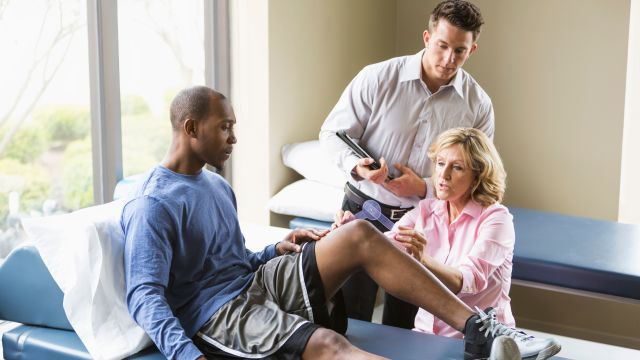More than one million Americans undergo a total hip or total knee replacement each year. Because both surgical procedures typically involve weeks of painful recovery, surgeons often need to prescribe opioids to help relieve discomfort.
But according to Cameron Ledford, MD, an orthopedic surgeon at Kansas City Joint Replacement in Overland Park, Kansas, these medications, although often required during the initial recovery, should be used only as needed and along with other non-opioid pain relievers as part of a “multi-modal” approach to treating surgical pain.
Why a multi-pronged approach may work best
The main potential downside to the use of opioids is that patients may find themselves becoming dependent on them and end up taking them much longer than is recommended.
In fact, 53 percent of knee replacement patients and 35 percent of hip replacement patients were still taking opioids six months post-surgery, according to a 2016 study published in the medical journal, Pain.
More recently, a study published in May 2018 in the journal Anesthesiology shows that using at least three different medications to relieve pain may be a better option than using opioids alone.
Researchers at the Hospital for Special Surgery (HSS) in New York City looked at more than 500,000 total hip replacement patients and more than 1 million knee replacement patients from 2006 to 2016. They found that those who got an opioid along with at least two other forms of pain medication, such as acetaminophen and a nonsteroidal anti-inflammatory drug (NSAID), had better outcomes. These patients not only needed up to 18.5 percent fewer opioid prescriptions post-surgery, but they also had a reduced risk of respiratory and gastrointestinal complications and required shorter hospital stays than those who just got opioids.
“Multi-modal pain strategies have been advocated by sub-specialists for over a decade, but is really now becoming the standard of care after total joint surgery,” explains Dr. Ledford. “While opioids definitely have a role during and immediately after surgery, some patients can begin to take too much and become dependent on the narcotic medication. But if you rely on several other alternative forms of pain relieving medications to help, you can significantly reduce the amount of opioids in both the short and long-term.”
Here are four ways to reduce your need for potentially addictive opioids after joint replacement surgery:
Make sure you’re getting some medication before surgery
“We give patients several medications such as acetaminophen, anti-inflammatories and gabapentin (a nerve pain medication) a few hours before surgery, while they are sitting in the preoperative room,” explains Ledford. “It’s thought that taking them before the operation can blunt or even prevent the inflammatory cascade and pain reaction that occurs after the soft tissue injury or surgery. As a result, it can help proactively reduce some of the pain.”
Translation: You may be less likely to need to rely on opioids later on. And a study published in April 2018 in JAMA Surgery found that taking preoperative gabapentin helped patients get off opioids after surgery faster than did taking a placebo.
Use alternative forms of anesthesia
Rather than relying strictly on general anesthesia, “we like to utilize spinal and regional anesthesia for these types of surgeries, since they can reduce the amount of opioids required during the procedure,” says Ledford. He also recommends some form of local anesthetic, which involves injecting an anesthetic around the surgical joint area to block pain.
Use the right combination of medications
The HSS researchers found that a combination of NSAIDs and COX-2 inhibitors (drugs such as celecoxib, or Celebrex) were the most effective when it came to reducing both complications and opioid prescriptions. Both these drugs reduce the inflammatory cascade of chemicals that occur post-surgery, thus helping to prevent pain.
In general, there are four general tiers of drugs for you and your doctor to consider.
- OTC (over-the-counter) acetaminophen and NSAIDs. These are often both used together as first-line treatment for mild to moderate acute pain, says Ledford. You’re put on a schedule where you alternate use of one or the other every few hours. “They have a synergistic effect as both have different mechanisms of action,” explains Ledford. “The acetaminophen is a general pain reliever, while the NSAID is an anti-inflammatory.”
- COX-2 inhibitors. These prescription medications work by blocking a specific enzyme, COX-2, which is responsible for making prostaglandins, chemicals that trigger inflammation or pain. COX-2 inhibitors are stronger forms of NSAIDs that can be used in place of the NSAID in an acetaminophen-NSAID combination and generally, you alternate the use of a COX-2 inhibitor with acetaminophen.
- Nerve pain medications. Drugs such as gabapentin (Neurontin) or pregabalin (Lyrica) can help calm any neuropathic, or nerve-related, pain stemming from the surgery. “This isn’t something we routinely schedule, like acetaminophen and NSAIDs, but it’s there if patients need it,” says Ledford.
- Opioids. If the above three aren’t enough to quell pain, then opioids may be added. “Most patients will need to be on opioids regardless for at least a few days to weeks after surgery, but some won’t require them after that if they rely on the tiers of drugs described above,” explains Ledford. “In our office, we have a protocol where we manage our patients on opioids for anywhere from two to six weeks, with the goal of weaning them completely off by six weeks.” Don’t just stop taking your opioids yourself cold turkey, he warns, since you need to gradually taper your dose to reduce the risk of withdrawal side effects.
Make sure you stay as active as possible post-surgery
Before you leave the hospital—generally anywhere from one to three days after surgery—you’ll need to prove you can do certain things such as getting in and out of bed alone and walking with an assistive device like a cane or walker.
“Ideally, you want to be standing and even taking a few steps the same day after having your surgery,” says Ledford.
Once you’re home, it’s important to follow any prescribed exercises and to start physical therapy as soon as your surgeon tells you to.
“The more you get up and move safely within reason, the more you’ll start building muscle strength and endurance again,” adds Ledford.






